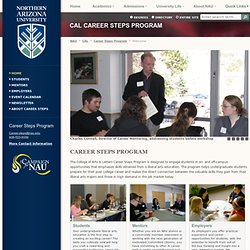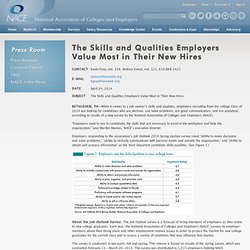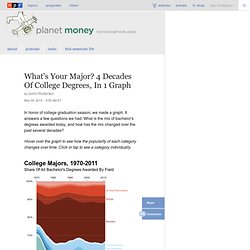

Arizona Statewide Career Services Conference 2014. Welcome - CAL Career Steps Program. Charles Connell, Director of Career Mentoring, addressing students before workshopMentor, Ernie Strauch, with students at workshopMentor, Barbara Litrell, with students at workshopCareer Services expert presenting on resume to Career Mentoring studentsStudents at Resume WorkshopMentor, Warren Sanford, with students at workshop The College of Arts & Letters Career Steps Program is designed to engage students in on- and off-campus opportunities that emphasize skills obtained from a liberal arts education.

The program helps undergraduate students prepare for their post college career and realize the direct connection between the valuable skills they gain from their liberal arts majors and those in high demand in the job market today. StudentsYour undergraduate liberal arts education is the first step to creating an exciting career! The skills you cultivate now will help you craft a rewarding and purposeful profession. The Skills and Qualities Employers Value Most in Their New Hires. BETHLEHEM, PA—When it comes to a job seeker’s skills and qualities, employers recruiting from the college Class of 2014 are looking for candidates who are decisive, can solve problems, are good communicators, and are analytical, according to results of a new survey by the National Association of Colleges and Employers (NACE).

“Employers want to see in candidates the skills that are necessary to excel in the workplace and help the organization,” says Marilyn Mackes, NACE’s executive director. Employers responding to the association’s Job Outlook 2014 Spring Update survey rated “ability to make decisions and solve problems,” “ability to verbally communicate with persons inside and outside the organization,” and “ability to obtain and process information” as the most important candidate skills/qualities.
(See Figure 1.) About the Job Outlook Survey: The Job Outlook survey is a forecast of hiring intentions of employers as they relate to new college graduates. How Liberal-Arts Majors Fare Over the Long Haul - Students. By Beckie Supiano Skepticism over the value of a college degree, especially one in the liberal arts, is common these days.

Rising college prices, increasing levels of student debt, and a still weak job market all heighten doubts. Return on investment has become a popular research question, and a higher-education association released on Wednesday a report arguing that a liberal-arts major is a worthwhile choice. In recent years, new data have helped paint a detailed picture of what college graduates earn. Analyses have focused on what they make by major, or by degree program at particular colleges.
On Wednesday the Association of American Colleges and Universities—a champion of liberal education—stepped into the fray with a report, based on data from the U.S. The liberal arts and sciences have traditionally been seen as laying “a foundation for future learning in the professions and in scholarly work,” said Ms. Graduate Degrees Help Anthony P.
2013_EmployerSurvey.pdf. Transferable skills. Janet R.

Long Principal, Integrity Search Inc. Blog: LinkedIn: Twitter: @IntegritySearch Collaborating with and supporting humanities students may represent some of the most challenging—and rewarding—opportunities for career advisers. Outside of applying directly to graduate programs, these students can face challenges because their paths to internships and permanent employment are often not as well defined as those for more career-specific majors. Yet, as a longtime recruiter (and full disclosure: former English major) who has successfully placed hundreds of one-time English, philosophy, and psychology majors, I propose that the greater challenge may be an initially uncomfortable fit with traditional job-search methods.
For starters, amid the ongoing debate about the marketability of a liberal arts education, employers say they want the critical thinking skills that are, in fact, the cornerstone of a foundation in the humanities. Class of 2014: Top-Paid Liberal Arts Majors. Spotlight for Career Services ProfessionalsSpotlight for Recruiting ProfessionalsMay 14, 2014 Majors in languages and literature were the top-paid among Class of 2014 liberal arts graduates at the bachelor’s degree level, according to results of NACE’s April 2014 Salary Survey.

Foreign languages and literatures majors earned the highest average starting salary at $46,900, followed by English language and literature letters majors at $42,200. (See Figure 1.) Employers hiring foreign languages and literatures majors did so primarily to fill elementary and middle school teaching positions. Number, percentage distribution, unemployment rates, and median salaries of 25- to 29-year-old bachelor’s degree holders and percentage of degree holders among all 25- to 29-year-olds, by field of study: 2009 and 2012. Labor force participation, employment, and unemployment of persons 25 to 64 years old, by sex, race/ethnicity, age group, and educational attainment: 2010, 2011, and 2012. Unemployment rates of persons 16 to 64 years old, by age group and educational attainment: Selected years, 1975 through 2013.
CIP user site. What's Your Major? 4 Decades Of College Degrees, In 1 Graph : Planet Money. In honor of college graduation season, we made a graph.

It answers a few questions we had: What is the mix of bachelor's degrees awarded today, and how has the mix changed over the past several decades? Hover over the graph to see how the popularity of each category changes over time. Click or tap to see a category individually. A few notes: The persistence of business. The decline of the education major. The rise of health professions. The data come from the National Center for Education Statistics.